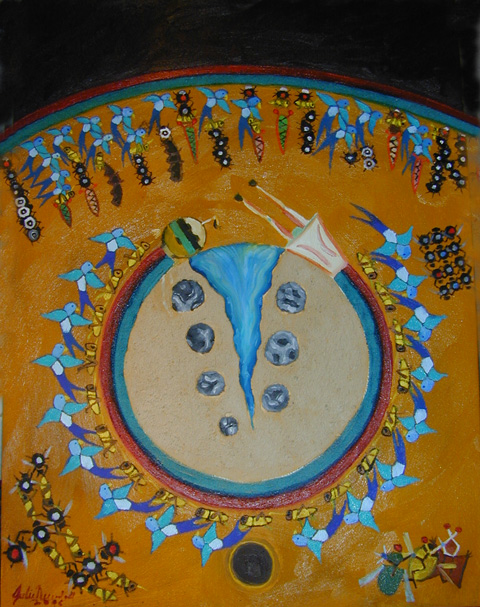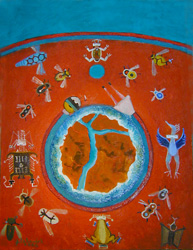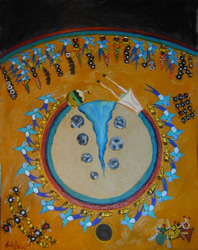The Dine' (once called Navajo, they prefer the term Dine') Creation myth lends itself well to an evolutionary perspective on the origin of life, where everything did not appear fully formed all at once, but began as a more primitive world, and gradually refined itself into what we are now. The first beings, according to their beliefs, were called Air Spirit People, and were essentially insects. They started out in a place called the "Red World". From here, they moved on to the Blue World, where they met up with slightly more advanced beings, such as the blue Swallow People. From here, they went to a Yellow World, then a Black and White World, and finally the sparkling world that we now live in. In each world, the Air Spirit learn how to behave a little better, are joined by more complex beings, and finally crude human types. Only in the last, fifth world do humans become fully human, and the rest of their stories can then continue with the new people on earth.
Current thinking on the Origin of Life talks about different worlds, also. The most famous is RNA world, just before our current DNA world, where RNA was keeper of all the information as well as doing the work of proteins. RNA world is reflected in the black and white, fourth world, in this series. Before this came Polymer World, cruder polymers that must have lead up to the more sophisticated RNA molecules. Before this came Sugar World, according to scientist Arthur Weber of the SETI Institute, who generously consulted with the artist on this series. In his view, sugars generate autocatalytic products that have the ability to make more of themselves once you have one, comprised the first microcontainers in which the chemistry of life could take place. In a similar way, life today uses sugars as our energy source, and has a lot of sugars in its chemical makeup. The evolution of the genetic material can be seen around the central sphere, while the evolution of the container or membrane later on can be seen up at the interface to the worlds to come under the arch. Scientist Robert Stroud of UCSF kindly provided information on thoughts about the evolution of membranes and the emergence of proteins.
A point of interest for these paintings is that dirt collected from the Southwest desert regions, around where the Dine' once thrived and still live, is used for the central spheres. The artist collected this dirt years ago on a trip through the desert, intrigued by the variety of natural colors she found. Dine' dry painting (or sand painting) artists go up into the hills to their own secret places to gather colored earth and stone to grind for their creations.
PLEASE NOTE THAT THESE ARE NOT THE FINAL PHOTOGRAPHS. The finished paintings will be on line shortly. See larger photos below.
The translation used for this series comes from the most recent "Dine' bahane'; The Navajo Creation Story" by Paul G. Zolbrod, University of New Mexico Press, 1984, ISBN 0-8263-1043-5. The paper on Sugar world , and much verbal communication, is from Arthur L. Weber. His paper on the topic is "Growth of Organic Microspherules in Sugar-Ammonia Reactions", Origins of Life and Evolution of Biospheres (2005) 35:523-536.
|
|
|
 |
The First World was Red
30" x 40"
Oil / mixed media on canvas
The first world had twelve kinds of Air Spirit People, which were flying insects. There were four gods in the four directions. In Dine' artwork, east is often up. This is because a rainbow person protects the painting by encircling it on three sides, but leaving the east side open, as it does not need as much protection. The promiscuous behavior of the Air Spirit people angered the four gods. They cause a flood of waves coming from all directions, forcing the Air Spirit people to flee through a hole in the eastern sky to the next, blue world.
Hadean World, our most primitive earth, was also red. A molten sea of lava may have seethed just underneath much of the earth's crust, although recently it has been discovered that water and ice may also have been present in the early earth years. The first chemicals of life are reflected in the bodies of the flying insects. This world was destroyed by water, perhaps like the waves that huge meteors would have caused many times during this age.
|
 |
The Second World was Blue
30" x 40"
Oil / mixed media on canvas
In the Blue World, the Air Spirit people meet up with the blue Swallow People. They live in cone shaped houses with holes in the top. The Air Spirit people mix with the Blue Swallow people. Their behaviour causes them to again be driven out of this world into the next, yellow world.
This could be called Sugar World in the Origin of Life scheme. The earth is cooling down now, and so blue reflects this. Some type of containers or means of isolating pockets of chemicals for life's first experiments are seen here. The Blue Swallow People represent sugars, a possible substance which formed these containers. They form microspheres to contain the first chemical experiments of life on earth. In the central holes, looking in on the Swallow People homes, the small white forms are taken from a paper by Art Weber on the subject of sugars as the first containers for life on earth. They are both the catalytic material and the container in this world. Each insect represents a chemical that may have been present at this stage on earth.
|
 |
The Third World was Yellow
30" x 40"
Oil / mixed media on canvas
In the Yellow World, the Air Spirit People meet up with the Yellow Grasshopper People. They lived in little holes in the ground along a river that flowed east to west, but dried up along the western edge.
In the Origin of Life scheme, this would be called Polymer World. Unknown polymers, early life experiments with chains of molecules, are forming. Many types of short polymers form a new membrane at the upper arch to latch onto and replace the sugar capsule. The genetic material is starting to form around the central sphere, composed of sugars and now phosphates, represented by the Yellow Cricket People. Tiny peptide chains are forming, symbolized by the grouping of amino acid insects in the lower right. Imaginary polymers other than RNA float around in the lower left and upper right. |
 |
The Fourth World was Black and White
30" x 40"
Oil / mixed media on canvas
In the Black and White World, beings live in upright houses. They seem to be early, primitive people, but not quite real humans yet. The Air Spirit People must cross a red river that runs east to west to meet up with these people.
This might be RNA world in the Origin of Life scheme. Four grasshoppers appear in this world - white, blue, yellow and black. These become the bases for the genetic material, RNA, around the central sphere. The membrane has fewer types of lipid structures than polymer world, as these molecules become refined and selected for the best variety, at the top near the arch. A small protein strand appears in the lower right, in the body of "Big Fly", considered a protector image by the Dine' . As RNA could not exist in very long strands, proteins would not have been very long, either. |
 |
The Fifth World began as an Island
30" x 40"
Oil / mixed media on canvas
At the Dawn of primitive human arrival in the fifth world, they find themselves on an island surrounded by water after travelling through a reed to escape a flood of water in the fourth world. In this world, the final human form is quickly completed, and many types of animals begin to appear. Coyote, howling at the top under the arch, is an important figure in Dine' legend. He appears around this time and influences a lot of what happens at this early stage, such as the placement of the stars.
The image of an island surrounded by water indicates here the arrival of the cell with a nucleus on the stage of the Origin of Life. RNA has now given rise to DNA, the genetic material of our current world. The membrane now has the final chosen few lipids of various types at the upper arch. Larger proteins can now be created, represented by the protector figures on the bottom left and right. They have the helix (right) and sheet (left) motifs of proteins on their bodies. Coyote represents proteins, which are involved in most aspects of cellular life. He sits in the membrane like a membrane protein, which controls what enters and leaves a cell.
|
|
|
|









